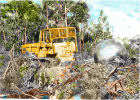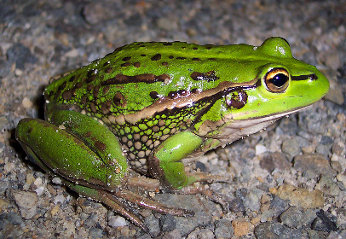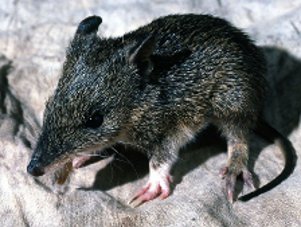Urban sprawl -biodiversity wrecking-ball
 The Growling Grass Frog, one of the largest frog species in Australia, was previously widespread across Victoria. They are now endangered. Southern Brown Bandicoots once occurred commonly in the wider Frankston area (pre-1970s). They have rapidly declined and are now restricted to isolated remnant habitat patches. They have little chance of long term survival against the economic benefits of population growth. Without robust ecosystems, with each natural species contributing its part to the web of life, we end in a barren, artificial and sterile, wastelands. (First posted
The Growling Grass Frog, one of the largest frog species in Australia, was previously widespread across Victoria. They are now endangered. Southern Brown Bandicoots once occurred commonly in the wider Frankston area (pre-1970s). They have rapidly declined and are now restricted to isolated remnant habitat patches. They have little chance of long term survival against the economic benefits of population growth. Without robust ecosystems, with each natural species contributing its part to the web of life, we end in a barren, artificial and sterile, wastelands. (First posted
Posted July 13th, 2012; Reposted July 15, 2012.)
The Growling Grass Frog, one of the largest frog species in Australia, was previously widespread across Victoria. They were once so abundant In Victoria that they were used for dissections in universities and to feed the snakes at the Melbourne Zoo.

The now endangered Growling Grass Frog were once so common around parts of Melbourne that they were the only frogs people saw.
Worldwide, amphibian have declined and become extinct at a greater rate over the past fifty years than birds, reptiles and mammals. Australia alone has seen the extinction of eight frog species in recent decades. At least 27% of the 219 Australian frog species are threatened with extinction.
Wildlife species cannot be “saved” in the long term by protecting them solely in captivity in zoos or small reserves. Without the existence of sustainable wild populations interacting with their environment, and evolving, each species will end up hopelessly inbred, and eventually doomed to extinction. Apart from high quality wetlands, they need grassland habitat for foraging, dispersal and shelter, and overwintering sites.
An anthropocentric colonial concept assumes that "vacant" land is a wasted resource unless there is concrete, lawns, landfill, infrastructure and housing on it.
The framework to protect our native species, even endangered ones, can easily be "revised" and made impotent against the lucrative economic momentum of the property development industry.
The expansion of the urban boundary is not really urban planning but a caving into market forces and the greed for growth.
Native species are victims of relentless government efforts to increase the size of our economy. However, each species, even humble native frogs, have intrinsic value and a role to play in maintaining our shared ecological foundation.
Protecting Marvellous Melbourne
Part of the problem of protecting Melbourne's "marvelous" status is that Melbourne's population continues to grow. Those governing and making decisions on planning assume the adage that "growth is good". Population growth has become a synonym for economic-growth.
We are outstripping our ability to provide for the demands of our swelling population. This is a time of job losses, and a decline in our once vibrant manufacturing base. An economy that relies on housing inevitably comes hits the limits of growth with the inability of being able to fund infrastructure, especially for the outer growth suburbs.
We are being strangled by an economy built for failure. The short-term benefits of land taxes, cash flows and stamp duty etc fail to cover the long term costs of urban expansion.
The goal should be to grow the economy until the costs are higher than the benefits. At this stage we need wisdom, and the political willpower to stop growing. Our growth is now uneconomic, counterproductive and destructive.
City planning has become synonymous to the greed for growth at all costs.
Protection for species being wound backwards
Protections for key threatened species in areas added to Victoria's urban growth boundaries by the Baillieu government have been wound back under yet to be released biodiversity plans.
Under the revised plans — which still need approval by the Commonwealth — proposals for wildlife corridors for rare bandicoots have been scrapped and buffer zones for threatened frogs reduced.
The Southern Brown Bandicoot, which is listed as threatened in Victoria, would have set up corridors for the species to move between habitats in Melbourne's south-east, will be re-written by the end of the year – no doubt watered-down to make more ease for developers.

Southeast Melbourne and the Westernport region are home to some of the few remaining populations of Victoria's endangered Southern Brown Bandicoots outside of national parks.
The proposed buffer zones around waterways and wetlands to protect the Growling Frog populations will also be reassessed and weakened. It's an effort to make green wedges and conservation corridors more rubbery and eventually non-existent.
According to the VPNA media release 12 June, Obviously the Victorian Government has been captured by developers and is failing to take into account long-term conservation and community needs.
Prescriptions for strategic assessment
On 16 April 2010, the federal environment minister approved several prescriptions for ecological communities and threatened species associated with the Melbourne strategic assessment. These prescriptions specify requirements for protection of nationally protected matters that must be followed in preparing precinct structure plans and in undertaking individual developments.
The expansion of Melbourne's urban growth boundary will also include the clearing of critically endangered grassland and woodlands, as well as the establishment of large grassland reserves west of the city and 200m wildlife corridors on each side of creeks.
Our slow-evolving species need to adapt to more disturbances, smaller fragments, narrower gene pools and thinner remnant habitats - what the developers and our State government condescends to “save” for them.
Southern Brown Bandicoots once occurred commonly in the wider Frankston area (pre-1970s). They have rapidly declined and are now restricted to isolated remnant habitat patches. Presently there are only two known populations within 15 km of the Pines Flora Fauna Reserve, namely the Royal Botanic Gardens Cranbourne (RBGC) and at Quail Island in Western Port Bay. The population at RBGC is the only population in the greater Melbourne area large enough and managed appropriately to be considered secure. It's the thin-edge of the knife!
Nationally threatened species such as the Southern Brown Bandicoot, Growling Grass Frog and the critically endangered Golden Sun Moth should be protected before final urban growth plans are released. But this hasn't happened as yet! Instead of green landscapes and green policies, they are being based on greed.
"Furry friendly" Peninsula Link?
Peninsula Link's builders are spending $20 million on eco-friendly initiatives including a "furry freeway" for endangered wildlife. A 30m-wide underpass will allow animals including the protected southern brown bandicoot to cross below the freeway. Picketers were attempting to save native bushland from being cleared until the appeal was heard and were keeping a 24-hour vigil at the Frankston South Westerfield property, a pristine pre-settlement biodiversity hot-spot. Bulldozers razed the area anyway, and the “furry freeway” for endangered wildlife is simply tokenism. Property prices in the Peninsula are expected to surge.
Green wedge backlash
Coalition co-ordinator Rosemary West said the inclusion of a Cranbourne South egg farm within the urban growth area could rebound on the government at the next election. Planning Minister Matthew Guy announced the decision to rezone the 104-hectare Brompton Lodge egg farm in June this year following a logical inclusions review. The review committee concluded it was not high-quality agricultural land and the egg farm was not viable in the long term. What is “viable in the long term” now? Nothing in the way of “progress” and urban sprawl!
It also recommended incorporating the adjoining Ranfurlie Golf Course within the urban growth area. Coalition co-ordinator Rosemary West said the rezoning was very poor planning, with Brompton Lodge surrounded by green wedge on two of three sides.
It's beautiful land, it's in the path of a proposed southern brown bandicoot corridor between the Royal Botanic Gardens at Cranbourne and The Pines Flora and Fauna Reserve in Frankston North , and it's a viable egg farm. It's doomed to yield 1100 housing lots!
Native animals, conservation corridors, food production, green wedges and picturesque land and our city's “lungs” can't hold back the spread of concrete, housing and the lucrative profits from population growth.
Federal Environment Minister Tony Burke will have to give environmental approval before the growth plans can proceed. However, with State government having control over biodiversity and with no population policy coming from Burke, also the Minister of Sustainable Population, there is little chance the answer will be “no”!

Recent comments